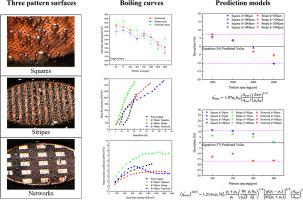International Journal of Multiphase Flow ( IF 3.8 ) Pub Date : 2024-01-20 , DOI: 10.1016/j.ijmultiphaseflow.2024.104735 Linfeng Xiang , Yindong Song , Dongshu Yang , Ziyun Zhang , Shouguang Yao , Kambiz Vafai

|
This study demonstrated that combination hydrophilic copper and hydrophobic nano-silver surfaces simultaneously enhanced the critical heat flux (CHF) and heat transfer coefficient (HTC) in pool boiling heat transfer (BHT) with deionized water as the employed working fluid. To further investigate the influence of geometric factors on heat transfer, this study designed three patterns denoted as squares/stripes/networks, ranging from 50μm to 3000μm. The effects of pattern size d, spacing p, and pitch ratio p/d on heat transfer results were obtained. Based on bubble visualization, the study further analyzed the reasons for inflection points in the boiling curve and the mechanisms caused by porous hydrophobic coating. Finally, the study proposed a numerical model suitable for predicting CHF of biphilic surfaces based on Helmholtz instability and Taylor instability. The model began with vapor columns escaping toward far-field and the fluid supplied to the heating surface. Concrete model derivation and adjustments are categorized according to the relationship between pattern size and bubble detachment diameter. For surfaces where the bubble detachment diameter exceeds the pattern size, this study originated from the perspective of Helmholtz instability on the vapor column surface. The resulting model is anticipated to quantitatively solve for the former and modulate the wavelength of Taylor instability on biphilic surfaces. Regarding surfaces with bubble detachment diameters smaller than the pattern size, this research begins with the existence time of the micro-liquid layer. The derived model validates the predominant role of p/d in the CHF values on micron-scale biphilic surfaces.
中文翻译:

基于亥姆霍兹不稳定性和泰勒不稳定性的双亲表面沸腾机理
这项研究表明,在以去离子水为工作流体的池沸腾传热(BHT)中,亲水性铜和疏水性纳米银表面的组合同时提高了临界热通量(CHF)和传热系数(HTC)。为了进一步研究几何因素对传热的影响,本研究设计了三种图案,表示为正方形/条纹/网络,范围从50μm到3000μm。获得了图案尺寸d、间距 p和节距比 p/d 对传热结果的影响 。基于气泡可视化,研究进一步分析了沸腾曲线拐点的原因以及多孔疏水涂层引起的机理。最后,研究提出了一种基于亥姆霍兹不稳定性和泰勒不稳定性的适合预测双亲表面CHF的数值模型。该模型从蒸汽柱逃向远场开始,流体供应到加热表面。具体模型推导和调整根据图案尺寸与气泡脱离直径的关系进行分类。对于气泡脱离直径超过图案尺寸的表面,本研究源于蒸气柱表面亥姆霍兹不稳定性的角度。预计所得模型将定量求解前者并调制双亲表面上泰勒不稳定性的波长。对于气泡脱离直径小于图案尺寸的表面,本研究从微液层的存在时间开始。导出的模型验证了p / d在微米级双亲性表面上的 CHF 值中的主导作用。



























 京公网安备 11010802027423号
京公网安备 11010802027423号